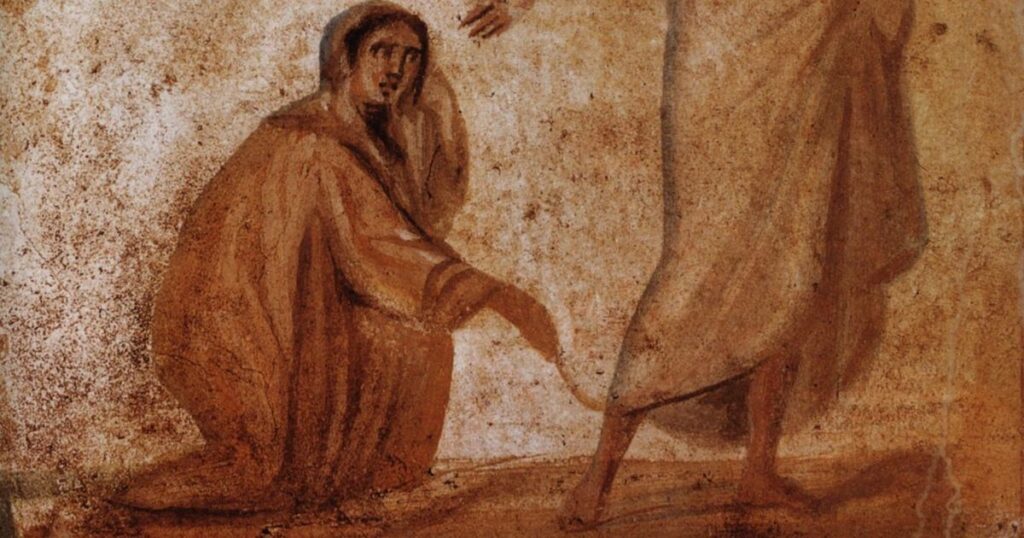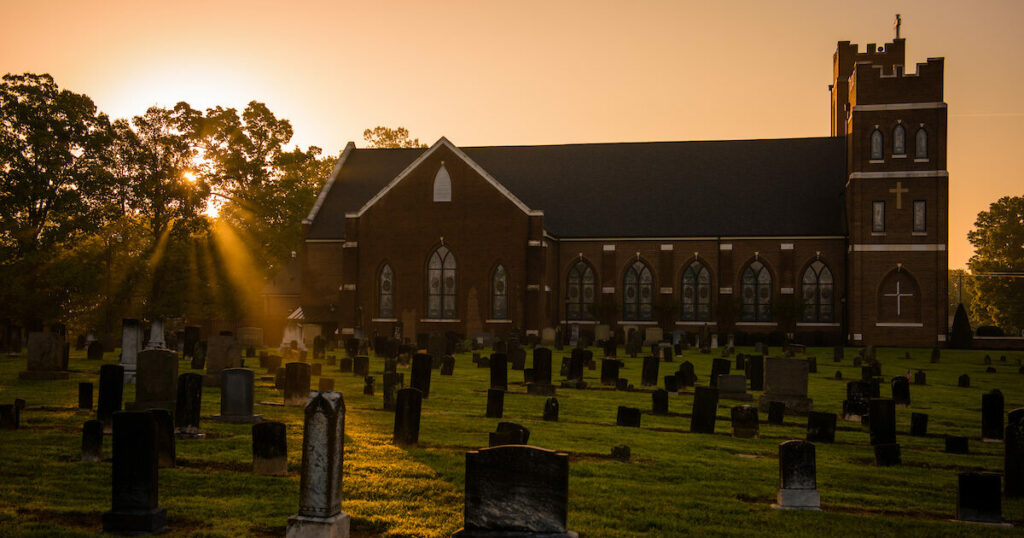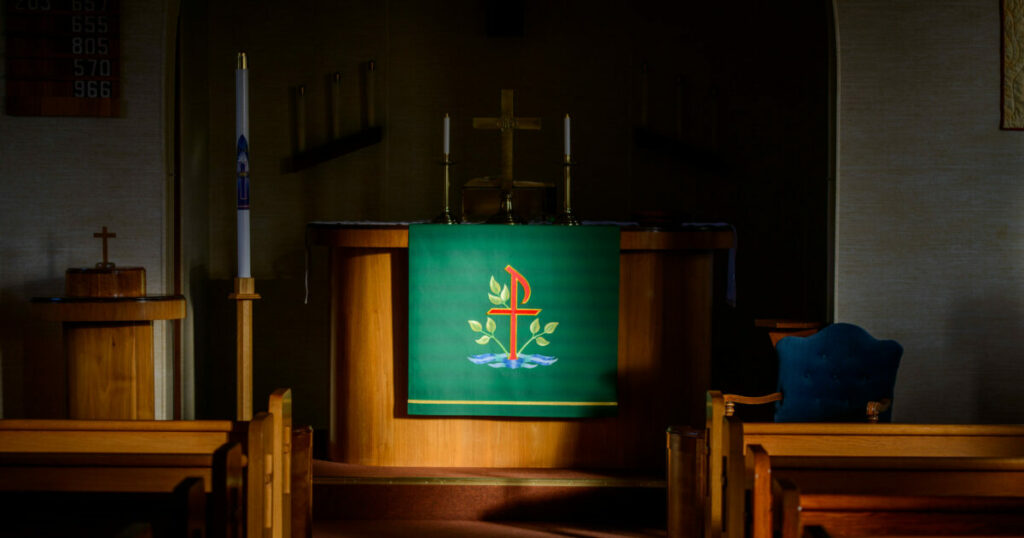I eased back into the driver’s seat and shut the door. With the windows rolled up and the sunlight streaming in, our minivan felt like a sauna. Organ music crackled through the car radio.
“Mom, are you crying?” My son leaned forward from the back seat, his voice full of concern. I didn’t answer him at once. I had no words.
“Mom?”
My daughter in the passenger seat next to me turned around and (almost) snapped at him, in that special way big sisters tend to have.
“She’s crying because she’s happy. OK?”
Blessed are the hungry
It had been six weeks since I last put on my Sunday clothes and herded my kids into the car for church. Six weeks since “worship” had meant more than leading family devotions and streaming sermons on YouTube. Six weeks since I had been to the table of the Lord.
And after six weeks, I was famished.
“Blessed are those who hunger and thirst for righteousness,” Christ says in Matthew 5.
Blessed was I, I guess. I hungered, and I thirsted.
“Do this in remembrance of Me,” Jesus said. Martin Luther reminds us in his Large Catechism, adding, “If you wish to be a Christian, you must from time to time render satisfaction and obedience to this commandment” (LC V 45, 49).
I certainly did wish to be a Christian (always have, still do), but “rendering satisfaction” in the midst of a statewide lockdown was frustratingly out of my hands.
So when I heard that one local church — a scant 30-minute drive away — was holding a Divine Service in its parking lot each Sunday, I got really, really excited.
“Shower!” I barked at my kids that Saturday night. “All of you! And use shampoo! We’re going to church tomorrow!”
Heaven on earth
Parking lot church during a pandemic, I should mention here, is not for the faint of heart. All the aesthetics and creature comforts that make church such a beautiful and pleasant experience — live music, friendly fellowship, pews and a working HVAC system — are completely stripped away.
That first Sunday we attended, the bulletin kindly asked us to keep our windows rolled up for the entire hour. Even in a cooler-than-average Michigan spring, we were drenched with sweat by the end of the sermon. We streamed the first part of the service on YouTube (with a two-second lag), then switched to a static-laden FM frequency for the Communion liturgy. There were no hugs; no handshakes; no friendly “hi, how are ya’s?” The closest thing I experienced to “fellowship time” that day came when I accidently left my headlights on throughout the service and needed a jumpstart from a church elder to get home.
Even the Sacrament was (at least from an earthly standpoint) a mere shadow of its usual glory. Masked ushers waved families from their vehicles one carload at a time. Each group then proceeded — awkwardly, hesitantly, carefully keeping a responsible “social distance” at all times — across the parking lot to a designated staging area at the edge of the lawn. There we applied hand sanitizer and waited for our turn at the makeshift altar —a card table with a white plastic tablecloth stretched over it. When it was time for us to commune, my eldest daughter and I walked up and stood before the altar, or as close to it as we dared (which is to say: not close).
Pastor Swem, gloved and masked, leaned forward and set down a disposable plastic plate and two wafers. He stepped back; we stepped forward.
“Take, eat. This is my body, given for you.”
We took. We ate.
Pastor Fleming, gloved and masked, leaned forward and set down two tiny silver chalices, each containing a sip of wine. He stepped back; we stepped forward.
“Take, drink. This is my blood, shed for you.”
We took. We drank. We applied more hand sanitizer.
An elder, gloved and masked, cleared away the plate and the cups, keeping the pastors’ hands clean and sterile for the next communicants. We bowed our heads in thanks and turned to walk back to our car, social distancing all the way.
If the church is, as Pope Francis sometimes likes to say, a “field hospital,” this church was a full-on mobile army surgical unit.
It was also heaven on earth.
I could feel the fear of death all around us in the parking lot that day — in the masks and the gloves, in the sickly sweet smell of disinfectant, in the awkward glances exchanged as people moved awkwardly around the parking lot — but it could not touch us. Out of love and concern for our neighbors, we exercised great caution, but we were not afraid. How could we be? Christ was with us.
Picnicking with the dead
As I sat there once again in the driver’s seat, waiting for the other families to take their turn at the altar, my imagination wandered — and I found my mind suddenly flooded with the image of Christian saints gathering in the Roman catacombs during the early centuries of the church.
Astute armchair historians may quibble with my impromptu reverie, pointing out that many scholars now believe popular accounts of early Christians worshiping in underground tombs during times of persecution to be only a myth. It is, as these scholars point out, really tough to prove from archaeology or contemporary texts that anything of the kind ever actually happened. I suppose they probably know what they’re talking about. Who am I to argue with scholars?
Yet, these same scholars cannot deny that early Christians did spend a fair amount of time down under the streets among the dead. Large rooms lined with benches reveal that catacomb gatherings did take place — though scholars believe these spaces were likely used not for corporate worship but to share meals with the dead (as if those two activities were in no way related). Deep down in the catacombs — tucked away from prying pagan eyes — engraved and frescoed walls display Christian themes and symbols that would have been frowned upon above ground: anchors, fish, lambs, doves, loaves of bread, even entire scenes from the Gospels and the Old Testament.
Reflecting on these ancient subterranean cemeteries, it occurred to me that each gallery, each work of art bears witness to something extraordinary in the lives of the Christians who carved them out so painstakingly: They did not fear death. So great was their confidence in the resurrection that these tombs held no more terror for them than picnic grounds. The catacombs were to them just one more place in which to testify boldly about their hope in the resurrection and the goodness of God.
A faithful YES
Regardless of whether or not Christian worship in the catacombs is a myth, the accounts of the church fathers and all those artistic expressions of Christian faith still displayed on those cold rock walls means that it is not a complete stretch to speculate that, given a choice between celebrating the Eucharist surrounded by darkness and decay in the catacombs or not celebrating the Eucharist at all, they would have chosen the catacombs every time.
In every generation since, believers throughout the world have faced similar dilemmas and found myriad opportunities to ask themselves:
If the only place the church could gather to hear the Word and receive the Sacraments was a [catacomb/graveyard/prison camp/cave/attic/parking lot], would I go?
For a blessed many Christian believers throughout history, the answer to questions like this has been a resounding, confident, faithful “YES.” Their lives and actions reassure us all that receiving the good gifts of God and the fellowship of believers is well worth braving danger, discomfort and dead car batteries.
Because God is good
Throughout the six weeks prior to my first parking lot Communion, my soul was fed by God’s Word as I read and watched and listened to faithful pastors over the airwaves and across the internet. I am thankful for each of them, as I am thankful for all pastors and church leaders everywhere who went out of their comfort zones to preach the Word in any way they could this spring.
Yet, I’d be lying if I didn’t say I was especially thankful for those brave church leaders who embraced any and every logistical challenge required to continue holding services in person. Thanks to their courage and creativity, my hungry soul was once again nourished that day by the true body and blood of the incarnate Word, “given and shed for the forgiveness of sins.”
And yes: I wept.
“Why are you crying, Mom?”
Finally finding my voice, I turned to face my son, my eyes still streaming.
“Because God is good.”
Rachel Bomberger is a writer, editor, home educator and Navy chaplain’s wife. She cohosts The Lutheran Ladies’ Lounge podcast from KFUO Radio (kfuo.org).






Thank you, dear Rachel, for the gift of your experience, which most of us can relate to.
The hunger and thirst while approaching, being fed and nourished while partaking, and being filled with His Grace and Peace along with the strength to carry on. As well as the overwhelming gratitude and overflow of joy through tears. ❤️
(Mom perked up when she heard your name announced, and then seemed to listen intently as you read. It was beautiful and brought years to my eyes.)
This was an excellent way to start the day. Thank you! Love and miss you!!!!
Nicely said. I’ll look forward to seeing more.
I loved every word! Could you share about the picture you used for this article? I’m assuming it’s a picture of “the woman with the issue of blood.” It’s wonderful and I need it in my home! Thank you for your ministry.
Sincerely,
Beth
Beth,
You are right, this is the women with the issue of blood. It’s from the catacombs of Marcellinus and Peter. It’s a public domain image that should be fairly easily found online.
Your narrative in words and voice over made me cry as we are still hungry and thirsty to partake in our Lord’s Supper and the Divine Service in India.
Thank you, this is so beautiful to relate to God’s calling us in the midst of this crisis similar to what early Christians faced when they worshipped in the Catacombs.
God be Praised!
Thank you, Rachel.
How hard it is to be separated even for a short time from the gifts of God! God be with you as we pray fervently together for an end to this pestilence.
This message hit home for me. Although I know that the real church is not a building with beautiful stain glass, & other Christians there is just something about being able to worship with our brothers, & sisters. We were able to do small group communion before our church re opened, & my heart filled with so much joy. Joy that I was alive , & healthy, & able to partake in the Lords Supper. I would travel to the darkest most desolate area to commune with God. So if anything this unsure scary time has renewed my faith, & drive for our Lord. I hunger and thirst for his word more now than before. He gives blessing in even the worst of times. He is so Good.
Amen! The church is not a building, but it *is* a people, and whenever God’s people must be separated from each other, the pain we feel is real. May we continue to be creative and energetic in our efforts to worship together and encourage one another throughout the present crisis.
This article touched me deeply. Thank you for writing it! I read it not long after attending a parking lot service for the first time. I understood the hunger—it had been 15 weeks since I last attended church. More significantly, it had been 7 years since I left the Lutheran church to convert to Catholicism. Over the years, I have wrestled with questions, uncertainty, and regret. I have prayed, studied, and prayed some more, and I recently decided to return to my Lutheran roots. The parking lot service marked my return (though I’ll be meeting with the pastor before receiving Communion). As I sat alone in my car, surrounded by strangers in the parking lot, I felt at home. My return took a lot of courage, and this article’s reflection on early Christians in the catacombs reminded me that it has always taken courage to follow Christ.
Welcome back, Kellie!
You left just about the same time we came to Lutheranism. After hopping from one church to another for years and years, trying to find our “best Theological fit”, my husband could no longer take another Sunday in Americhurchianity. He started to meet with Pr. Fleming (Pr. Swem’s predecessor). After a while, we joined OSLC in GR and find ourselves completely content in Confessional Lutheranism.
I can imagine to some degree what you wrestled with in the Catholic Church. Thanks be to God the Holy Spirit for working in all our lives and not letting us live with the discontentedness.